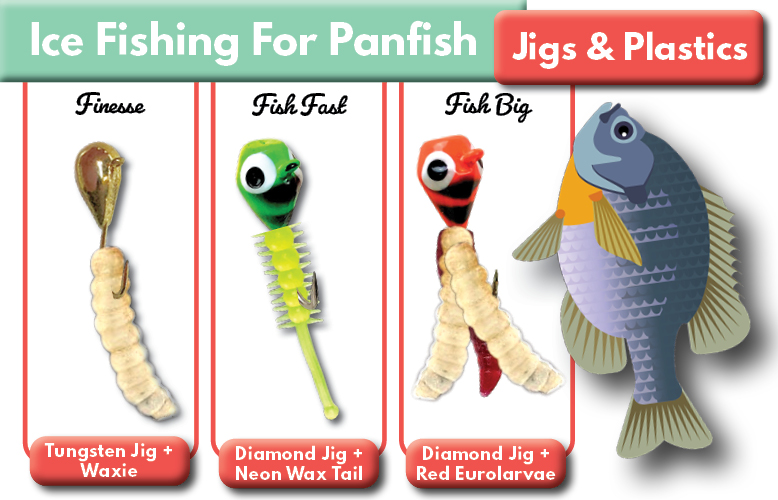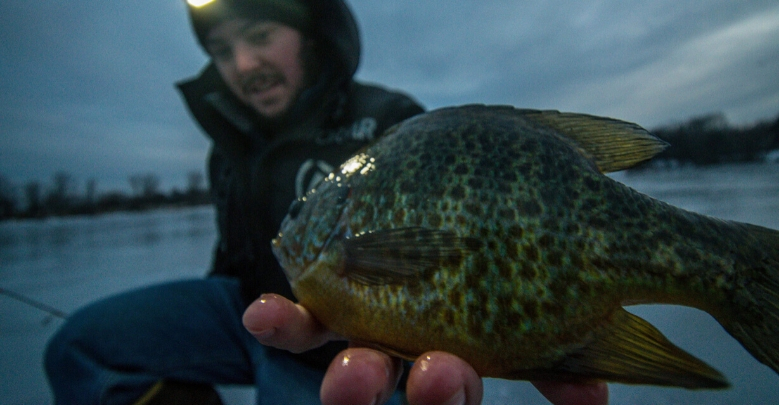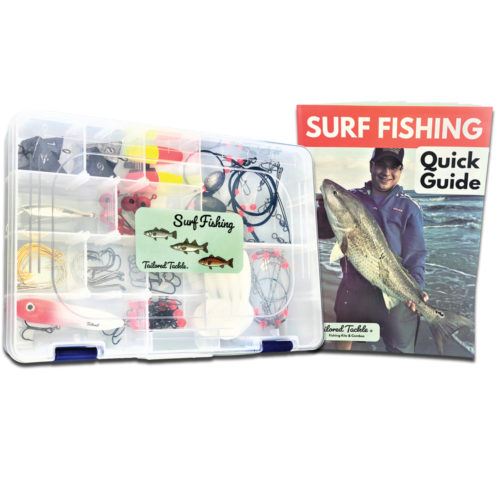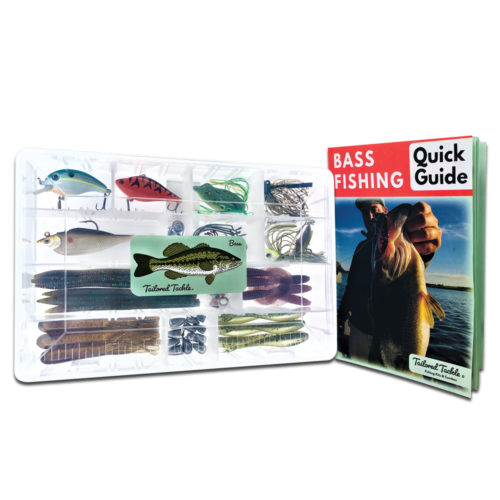Bluegill are arguably the most common fish across the ice belt. Most lakes have a healthy population of bluegill and sunfish just waiting for you to catch them. Their fairly small size and abundance make for fun filled days of jigging. Although they are small, their round body shape gives them more leverage in the water and a pretty good fight on light tackle. When ice fishing for bluegill, you can expect constant action because they are generally congregated in large schools. Bluegill can be trickier to catch in the winter, but you will have good success using jigging tactics to catch them.
How to Catch Bluegill Ice Fishing
Bluegill patterns and depths will vary throughout the winter. However, bluegill generally feed on small minnows, insects and larvae, so mimic them with your bait presentations. At early ice you will find bluegills in shallower bays with healthy amounts of vegetation. Look for bays with a maximum depth of 15-20 feet, and work from the deepest point toward the edges of vegetation. Bluegills will push out to the deeper basin in mid-winter when vegetation dies off and oxygen levels are depleted. You’ll find gills in the 15-35 foot range this time of year. Look for areas with flat, semi-soft bottoms. Flatter, semi-soft bottom areas are home to insect larvae that bluegills love to eat this time of year. Late ice will bring bluegills back to the vegetation as they make their way into shallow bays for the spring spawn. Target the mouths of bays, points and inlets as they travel inward.
Jigging for Panfish
Jigging with our ice fishing combo is a very effective way to catch bluegills, sunfish and other panfish. Three of our favorite finesse jigging tactics are pulsing, jigging up through the water column, and dead sticking. Pulsing a jig up and down with short vibrations of the rod tip is the most common tactic when ice fishing for bluegill. For more active fish, or to incite competition, pulse the bait slowly up and down through the water column. Active panfish are always looking upward and are willing to chase a bait if it is swimming towards the surface. Holding the jig completely still, also known as dead sticking, will entice finicky fish that aren’t committing to active presentations. We like to mix all three of these tactics together until the fish commit to the bait. Ice fishing electronics will help you see how the fish are reacting to your jigging techniques and dial in the right presentation.
Micro Ice Fishing Jigs for Panfish
Micro jigs provide subtle presentations that mimic the small insects and minnows that panfish feed on. Effective sizes for micro jigs range from 1/64 oz to 1/12 oz and ½ to ¾ inch long. Micro jigs made of tungsten work well for deep water because the dense metal lets you use a heavier weight but still have the micro size presentation. Lead micro jigs will work well in shallow water, where a heavy weight is not needed. We try to use brighter colors when ice fishing for bluegill like the three in our ice fishing kit. Perch tiger and orange tiger colors work well in dirty water because they are bright and draw panfish in. Our gold tungsten micro jig works well in all water clarity, but especially well in clear water where its shiny finish will catch their interest. Keep these tips in mind, but always rotate through colors and mix up plastic and bait combinations until you find the one that the fish like best.

Panfish Jigs & Soft Plastics Bait Pairing from our Ice Fishing Kit
Soft Plastics for Sunnys
Soft plastic ice fishing baits have become very popular among panfish fishermen. Plastics allow you to mimic live bait without having to re-bait your hook after every fish. Some of the most common live baits for ice fishing for bluegill are waxies and eurolarvae. The wax tail grub and spike larvae plastics from our ice fishing kit mimic both baits as well as insects and small minnows. Soft plastic paired with a live bait on a micro jig can be just the ticket for less active fish. We like to add a piece of waxie or a eurolarvae along with the plastic to provide real scent and taste. Having the plastic on your jig is a huge benefit if you are on a school of panfish that keep stealing your live bait.
Ice Fishing for Bluegill Tips
Finding a big school when ice fishing for bluegill can be a lot of fun so keep in mind these important ice fishing tips. Be sure to choose locations by the time of year. Use jigging techniques to lure fish and coax them into biting. Utilize micro jigs and plastics to mimic small insects, minnows, and most importantly larvae. Mix in live bait with your plastics to entice finicky fish and bigger fish. Put these tactics all together, keep track of what works best for you, and you’ll be more effective every time you target bluegill.











Leave a Reply